

Abrin. Abrin is a toxalbumin (with an LD50 of 0.7 µg/kg of body mass when given to mice intravenously,[1] and 10–1000 µg/kg when ingested by humans and 3.3μg/kg when inhaled by humans[2]) that is found in the seeds of the rosary pea (jequirity pea).
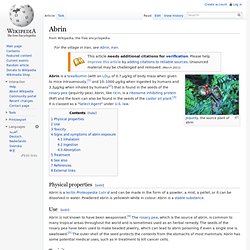
Abrin, like ricin, is a ribosome inhibiting protein (RIP) and the toxin can also be found in the seeds of the castor oil plant.[3] It is classed as a "Select Agent" under U.S. law. Physical properties[edit] Abrin is a lectin Proteopedia 1abr and can be made in the form of a powder, a mist, a pellet, or it can be dissolved in water.
Flowers. Lithops (Living Stone) seeds. Groundwater arsenic poisoning in Bangladesh: An interview with Dr Manzurul Hassan « Institute of Hazard, Risk and Resilience Blog. Dr Manzurul Hassan is geographer and faculty member of Jahangirnagar University in Bangladesh.
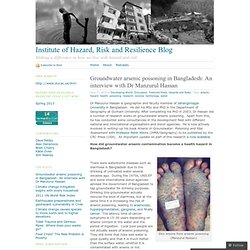
He did his MSc and PhD in the Department of Geography at Durham University. After completing his PhD in 2003, Dr Hassan did a number of research works on groundwater arsenic poisoning. Apart from this, he has conducted some consultancies in the development field with different national and international organisations and donor agencies.
He is now actively involved in writing-up his book Arsenic in Groundwater: Poisoning and Risk Assessment with Professor Peter Atkins (IHRR/Geography) to be published by the CRC Press (USA). Anti-Gaia: Arsenic Poisoning vs Lust for Gold. Arsenic poisoning is often an unintended consequence of sloppy gold, silver, and other mining operations, hitting people who rely on surface water sources and don’t have secondary alternatives.

Arsenic, named by the Greeks and Latins for its yellowish color, has a wickedly high boiling point and looks like a steel gray, brittle semimetal. Life Sciences Blog. Human Uses for Arsenic - Learn More. There are many different uses of Arsenic, but caution must be taken in every case.

Whether using Arsenic for wood preservation of as a conductor, it is a toxic element and must be handled with caution. Arsenic has been known since ancient times, though probably in compound form rather than in its pure state. It is used in combination with other materials in pigments, poison gases and insecticides (such as Paris Green, calcium arsenate and lead arsenate) and is well known from former use as a rat poison. Arsenic has a long history of medical applications; before penicillin was developed an arsenic compound was used to treat syphilis and yaws. Arsenic is used in ammunition manufacturing because it helps to create harder and rounder bullets.
Trimethylarsine. Trimethylarsine is the chemical compound with the formula (CH3)3As, commonly abbreviated AsMe3 or TMAs.
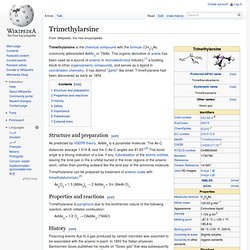
This organic derivative of arsine has been used as a source of arsenic in microelectronics industry,[1] a building block to other organoarsenic compounds, and serves as a ligand in coordination chemistry. It has distinct "garlic"-like smell. Trimethylarsine had been discovered as early as 1854. Structure and preparation[edit] As predicted by VSEPR theory, AsMe3 is a pyramidal molecule. Arsenic - Periodic Table of Videos. Plant Hardiness Zone Map. Trees for Life - Mythology and Folklore of the Rowan. The rowan's mythic roots go back to classical times.
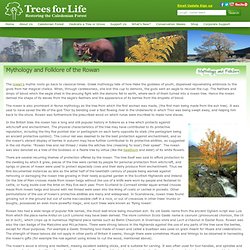
Greek mythology tells of how Hebe the goddess of youth, dispensed rejuvenating ambrosia to the gods from her magical chalice. When, through carelessness, she lost this cup to demons, the gods sent an eagle to recover the cup. The feathers and drops of blood which the eagle shed in the ensuing fight with the demons fell to earth, where each of them turned into a rowan tree. Hence the rowan derived the shape of its leaves from the eagle's feathers and the appearance of its berries from the droplets of blood. The rowan is also prominent in Norse mythology as the tree from which the first woman was made, (the first man being made from the ash tree).
In the British Isles the rowan has a long and still popular history in folklore as a tree which protects against witchcraft and enchantment. There are several recurring themes of protection offered by the rowan. Paul Kendall Rowan - related pages Species Profile: Rowan. Welcome to the Floral and Nursery Plants Research Unit Home Page. Friday, April 18, 2014 The Floral and Nursery Plants Research Unit is the research arm of theU.S.

National Arboretum, which is a division of theBeltsville Agricultural Research Center of theAgricultural Research Service of theU.S. Department of Agriculture. Back to the Arboretum Home Page Arboretum Information || Events & Education || Gardens & Horticulture || Research ActivitiesSupport the Arboretum || New Plant Introductions || USDA Plant Hardiness Zone Map || CommentsSearch Our Site Last Updated November 20, 2012 4:44 PMURL = narj Arboretum Information Events & Education Gardens & Horticulture Research Activities Support the Arboretum Search Our Site Arboretum Home/Front Page.
Wild ginger - Plant Encyclopedia - BHG.com. Hosta This plant hardly grown 40 years ago is now one of the most commonly grown garden plants.

But hosta has earned its spot in the hearts of gardeners -- it's among the easiest plants to grow, as long as you have some shade and ample rainfall.Hostas vary from tiny plants suitable for troughs or rock gardens to massive 4-foot clumps with heart-shape leaves almost 2 feet long that can be puckered, wavy-edged, white or green variegated, blue-gray, chartreuse, emerald-edged -- the variations are virtually endless. Hostas in new sizes and touting new foliage features seem to appear each year. Alkaloid. The boundary between alkaloids and other nitrogen-containing natural compounds is not clear-cut.[14] Compounds like amino acid peptides, proteins, nucleotides, nucleic acid, amines, and antibiotics are usually not called alkaloids.[2] Natural compounds containing nitrogen in the exocyclic position (mescaline, serotonin, dopamine, etc.) are usually classified as amines rather than as alkaloids.[15] Some authors, however, consider alkaloids a special case of amines.[16][17][18] Naming[edit] The article that introduced the concept of "alkaloid".
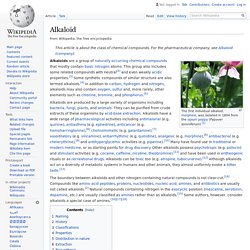
The name "alkaloids" (German: Alkaloide) was introduced in 1819 by the German chemist Carl Friedrich Wilhelm Meißner, and is derived from late Latin root Latin: alkali (which, in turn, comes from the Arabic al-qalwī – "ashes of plants") and the suffix Greek: -οειδής – "like". [nb 1] However, the term came into wide use only after the publication of a review article by Oscar Jacobsen in the chemical dictionary of Albert Ladenburg in the 1880s.[19][20]